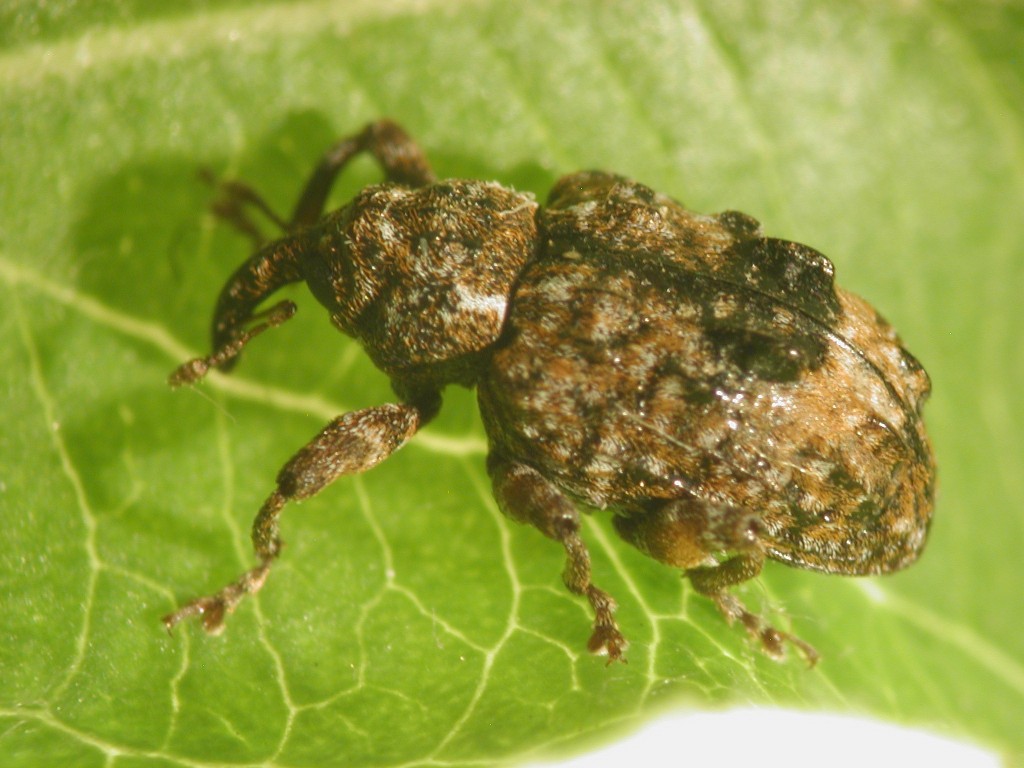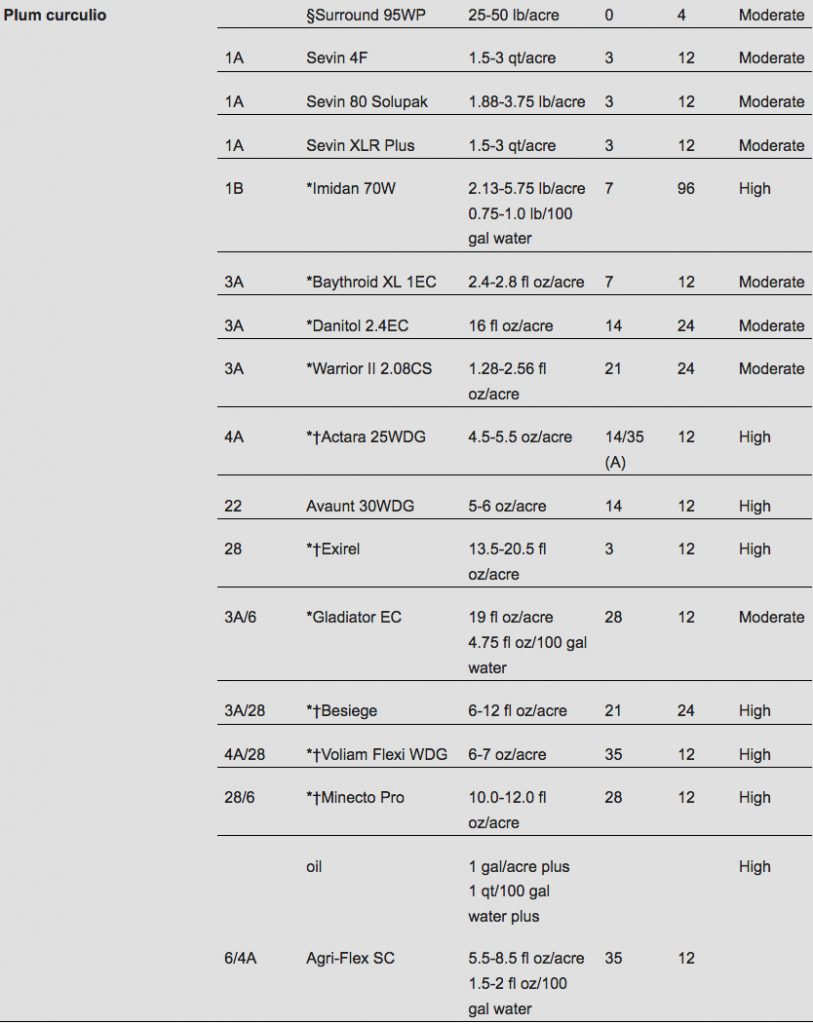
Overview: Warm temperatures today and tomorrow will give rise to insect activity (see Scouting Report).
We’re seeing the early onset of plum curculio (PC) egg laying in untreated Ginger Gold king fruit, the most valued of the fruitlets in the cluster, at 0.5% along abandoned orchard. Applications to manage PC should begin in southern, mid-Hudson Valley and warmer Columbia County sites as early varieties reach 80% petal fall.
Obliuquebanded leafroller (OBLR) and green fruit worm (GFW) are actively feeding on growing shoots at 0.5%. Damage from Locust leaf beetle has caused damage to developing foliage earlier in the season, visible as patterned shot holes as leaves unfurl at 1.0%.
Tarnished plant bug (TPB) feeding observed in early set fruit at <0.5%. (TPB Management link)
Brown Marmorated Stink Bug have been observed in very high numbers in pheromone baited Tedders Traps. This is the first year in which we’ve averaged over 15/trap/week in May. It may be that they were very successful during the fall feeding and overwintering period. BMSB have yet to be observed in orchards yet we should be on the watch, especially in stone fruit. Scouting for BMSB activity then should begin this week with applications of effective insecticides made at first adult observation in 100′ of perimeter orchard row. (BMSB Management Tools).
Low European red mite have been observed to date.
No significant feeding of flower clusters has occurred in untreated apple to date. Increased feeding as we move through petal fall will occur as temperatures rise.
In-Depth: Plum Curculio (PC): Cool temperatures have kept the lid on migrating populations of PC over the past two weeks, delaying and or reducing oviposition in stone fruit in many locations in the Hudson Valley. As we are nearing petal fall in the earliest apple varieties we observed the first sting from PC on fruit today, May 14th (See Scouting Report for all insects). We are looking at <1% PC injury in our untreated Ginger Gold in a heavily infested corner of our research orchard, in plots along an abandoned orchard to the north, a hedge row and woodlands to our east and south. In year in which warmer temperatures are present during bloom we would be looking at 50% injury by this point in time. PC activity is highly dependent upon temperature. In early varieties such as Ginger Gold applications should begin over the next two days as weather permits.
We’ve had relatively few consecutive days in late April and May in which the mean temperatures have been above 65F, the temperature at which PC begins migration to orchards. Since PC usually do not feed or oviposit when night temperatures fall below 50F, the few nights above 50F we’ve had to date did provide some opportunity for feeding that are reflected in very low sting numbers in fruit to date.
If the weather is extremely warm after petal fall, the oviposition cycle may be completed in 2 weeks. However, in cooler seasons as we are presently experiencing, PC may continue to oviposit for 4-6 weeks. If this trend holds we will be looking at the end of migration and oviposition in early June.

The model used to calculate the end of PC emergence begins at 95% petal fall of McIntosh. The majority of eggs deposited into fruit by overwintering plum curculio in the Northeast is completed in apples once 308 DD base 50 has been reached. (developed in studies conducted by by W. H. Reissig, J.P. Nyrop, and R. Straub (Environmental Entomology; 1053-1060; 1998; titled “Oviposition Model for Timing Insecticide Applications Against Plum Curculio (Coleoptera:Curculionidae) in New York State”).
In choosing insecticides for PC management, considerations should be made based on the mode of action of the active ingredient. John Wise, Michigan Stat Fruit Entomologist, discusses the Lethal, Antifeedant and Curative activities of insecticides that may be helpful in your decision making in tree fruit PC management. It can be found in the article titles ‘Effectively controlling plum curculio in stone and pome fruits‘.
We recommend maintaining residual protection from the high rate of an effective insecticide for PC. Take note that residual activity is no longer effective when 2 inches of cumulative rain occurs within the first 10 days after application, 1.5 inches of cumulative rain occurring from 10-14 days after application, or 14 days has passed since the previous application with no rain event. Rains today and tomorrow will significantly impact residual with 0.75″ having fallen over the past 8 hours and 0.5″ predicted for the next 24 hours. If your next application is applied over the next few days, consideration should be made for the new big pest, the codling moth.

Codling moth: The Tortricid complex of Red Banded Leaf Roller (RBLR), Oriental Fruit Moth (OFM), and Codling Moth are now in flight with the Obliquebanded Leafroller (OBLR) still in the larval stage moving toward pupation. The most important of the internal lepidopteran being codling moth, has taken flight with the first adult male found in pheromone traps today, May 14th in Highland. Today begins the degree day CM model in which we use 220DD accumulated degree days (base 50°F) to forecast larval emergence. We are predicting 1st CM larva emergence within the next 15 days or May 30th this season.
Of all the complaints I’ve heard over the past 8 months, the loss of sound fruit at pack out appears to be from codling moth. Over the past few years we have seen a rise in CM numbers in traps and in orchard infestations, culminating in 2016, in which the third generation emergence in September gave rise to very high losses.
Conventional material options are listed in the Cornell Guidelines.


An additional option is to apply a granulosis virus formulation at 200-250 DD 50°F. High moth pressure requires 2-3 sprays for the first generation, but in lower pressure orchards (with counts of less than 5 moths per trap per week), you can control CM with a single spray timed at 350 DD 50°F.Codling moth granulosis virus. Formulations include Cyd-X, Cyd-X HP, Madex HP by Certis; Carpovirusine by Arysta LifeScience. Cyd-X 0.06SC is applied @ 0.25-0.4 qt/acre and Carpovirusine 0.99SC @ 0.25-0.4 qt/acre.
Codling Moth Granulosis Virus contains an insecticidal baculovirus, Cydia pomonella granulovirus, which is specific to the larval form of the codling moth, and is registered for use in apples, pears, and (Cyd-X only) plums. This biological insecticide must be ingested in order to be effective, after which the viral occlusion bodies dissolve in the larval midgut and release infectious virions. These enter the cells lining the digestive tract, where they replicate; eventually, the other tissues are infected and the larva stops feeding and eventually (within 3-7 days) dies. After death, the larva disintegrates, releasing billions of new occlusion bodies, which may infect other codling moth larvae upon ingestion. No adverse effect to fish, wildlife or beneficial organisms has been observed; it has a low bee-poisoning hazard.
Insecticide Resistance Development in Codling Moth:
The organophosphate class of insecticides, including Guthion (azinphos-methyl) and Imidan (phosmet) have been used since the 1960’s, for over 50 years, to manage the codling moth. The development of resistance by codling moth to Imidan is likely if its reoccurring use has been for Plum Curculio and or OBLR management during mid-summer. Consistent use during the past ten years or more increasing resistance potential. Those specific timings would provide some level of control of CM while providing various rates of residual exposure. Low rates of residual increase the selection for resistance during the early and mid-summer generations of the pest. A scenario, such as the switch from Guthion to Imidan in season long program use would affect the same target site (nerve receptor sites for ACh, acetylcholinesterase) within the insect to contribute to resistance.
In the Hudson Valley to date I don’t believe resistant strains are widespread, even though we are hearing of increasing reports of CM damage to tree fruit. The broad availability and use of insecticides that include the different IRAC classes of active ingredients for plum curculio from PF to 2nd cover and mid-summer management of OBLR, would reduce region-wide resistance of CM to any one specific insecticide class. We have seen the use of these materials to include Avaunt, Exirel, Calypso, Carbaryl, pre-mixes including pyrethroids or pyrethroids alone. Insecticides of various classes for the overwintering OBLR used at PF would likely impact CM to a lesser degree when used at petal fall timing.
There haven’t been recent studies to detect phosmet resistance to CM in NY that I’m aware of. In Michigan, a study in 2008 detected a 7-8 fold level of resistance in orchard site specific CM populations to codling moth (see abstract from work done by John Wise in Mich. State below). However, no resistance to acetamiprid (Assail) and spinosad (Delegate, Spintor, Entrust) was detected in the study.
That said, it’s very likely we have codling moth populations resistant to older insecticide classes, including pyrethroids and OP’s in orchards throughout the Northeast.
Insecticide rotation: I would suggest the use of specific materials for CM be employed during 1st-2nd cover and again in mid-July, when model predictions for larva emergence are called for AND in orchards with reoccurring fruit injury from CM. The use of Assail to manage apple maggot during 2nd generation CM larval emergence has been a good option, as it’s been shown to be one of the better materials against both CM & AM. The use of Delegate, Altacor at 1st – 2nd cover would reduce the resistance potential while picking up a few lingering overwintering OBLR. Mating disruption and granulosis virus are also good choices in conventional and organic production systems.
Remember to rotate classes for EACH GENERATION and not each spray during a generation, to reduce the potential for insecticide resistance.
Mota-Sanchez D1, Wise JC, Poppen RV, Gut LJ, Hollingworth RM.
The codling moth is one of the principal pests of apple in the world. Resistance monitoring is crucial to the effective management of resistance in codling moth. Three populations of codling moth in neonate larvae were evaluated for resistance to seven insecticides via diet bioassays, and compared with a susceptible population. In addition, apple plots were treated with labeled field rate doses of four insecticides. Treated fruit were exposed to neonate larvae of two populations from commercial orchards.
RESULTS: Two populations of codling moth expressed two- and five fold resistance to azinphos-methyl, seven- and eight fold resistance to phosmet, six- and tenfold resistance to lambda-cyhalothrin, 14- and 16-fold resistance to methoxyfenozide and sixfold resistance to indoxacarb, but no resistance to acetamiprid and spinosad. The impact of the resistance to azinphos-methyl, measured as fruit damage, increased as the insecticide residues aged in the field. In contrast, fruit damage in methoxyfenozide- and lambda-cyhalothrin-treated fruit was observed earlier for resistant codling moth. No differences in efficacy were found for acetamiprid.CONCLUSIONS: Broad-spectrum insecticide resistance was detected for codling moth. Resistance to azinphos-methyl, lambda-cyhalothrin and methoxyfenozide was associated with reduced residual activity in the field. Broad-spectrum resistance presents serious problems for management of the codling moth in Michigan.

